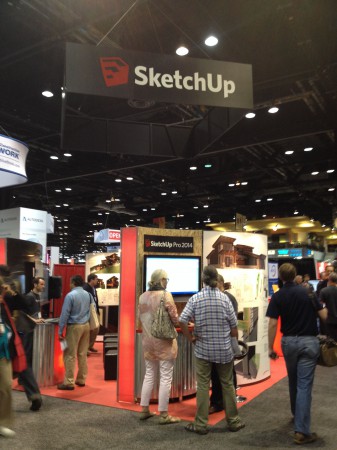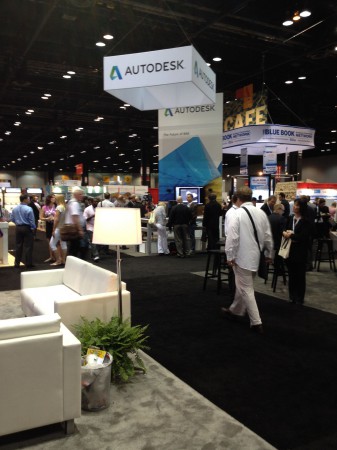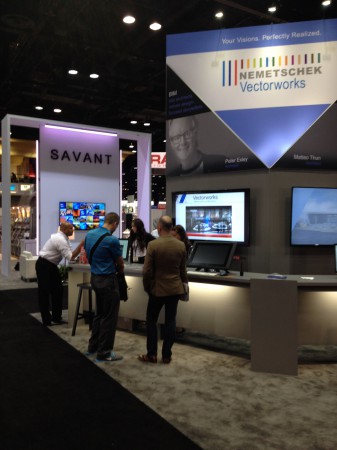The 2014 AIA National Convention and Exhibition this year in Chicago was a really nice experience, albeit a wee bit short for my liking. Too much travel and too much activity in my own architectural practice duties kept me from devoting that minimum week one really needs in order to truly experience what the Windy City has to offer in the way of architecture and culture. And speaking of wind, the two-plus days I was in Chicago were gorgeous in terms of the weather.
Software at AIA National
Every year I attend AIA I typically am invited to a series of meetings with software vendors. This year was no different and I had interesting and insightful conversations with the executives teams from Autodesk, Graphisoft, Trimble and Nemetschek Vectorworks. All four of these companies are relentlessly pushing at the boundaries of the innovation envelop in AEC software. Additionally, Bentley was at AIA and so was Gehry Technologies, two companies with significant and interesting software technologies. Both of those companies had smaller sized booths while the four aforementioned companies occupied the larger booths at the show directly at the heart of the Software Pavilion area.
And speaking of that, I wish that the show organizers would focus more attention on making sure that all software and computer hardware related companies can obtain spots in or on the edges of the Software Pavilion regardless of when they commit to the show. As GRAPHISOFT’s CEO Viktor Varkonyi stated to me, the AIA National Convention is increasingly becoming more important an event on their calendar. This means that the show works well for the “lead” development they are looking for. With software innovation being such a critical element within the profession’s evolving search for more social relevancy, it simply makes sense that the AIA focus on expanding the Software Pavilion area.
In terms of turn-out, there were a good amount of software companies, some of which I couldn’t get to due to their being scattered about the show floor. You will notice in the pictures that my speed necessary to getting around from meeting to meeting made taking booth photos a bit sloppy. Yes, there’s some blur and I apologize for that. Missing from this year’s show were, I believe, all the major larger format plotter people. Yes, no HP. Also missing was the Rhino folks, which is disappointing because the last show I remember them (was is Miami or San Francisco?) at they had a fantastic large booth with third-party folks at single-man stations and it was a really fascinating set of technologies to check out.

01 – Without a doubt the SketchUp booth always seems to be the busiest, followed very closely by Autodesk’s booth which often is setup classroom style. Trimble SketchUp was showing its latest 2014 version plus SketchUp Mobile.
Also missing, sadly, were the companies providing really strong and interesting mobile apps for iPad in particular. Where were the iPad apps? I can think of some killer apps for architects that would do well at the show, that architects would love to see, explore and consider buying. For example:
- Morpholio Trace
- Paper by 53
- MagicPlan
- inchCALC+
- Morpholio Project
- Newforma Plans and Newforma Punch List
- et cetera
Don’t get me wrong, there were iOS apps at the show. Autodesk, IMSI-Design and Bluebeam all have key mobile apps that are excellent for architects and AEC professionals. It’s just that there are so many others that could be present. Perhaps the Software Pavilion can evolve to provide a tiny one-man type of booth space aimed at just the mobile app world. That would be cool!

02 – The convention center in Chicago was capacious and well organized. It was also nice to enter predominantly from a certain side, it kept getting lost down to a minimum.
Autodesk tends to announce its next major versions for AEC tools earlier in the year and thus was at the show touting its 2015 product lines including Autodesk Revit 2015, Autodesk 3ds Max 2015, and other AEC tools, including its mobile tools. Revit enjoying the greatest mindshare and market share lead in the United States—for a BIM authoring tool—it was not surprising to see a large interest in the Autodesk booth at the AIA National Convention.

03 – Autodesk’s presence at the AIA show is always very strong. Their booth is really the only booth that rivals the SketchUp booth in terms of overall activity and popularity.
Autodesk was also at AIA talking about its upcoming cloud endeavor, currently code named, Project Skyscraper. The future BIM collaboration platform is aimed at tying together all project stakeholders, with all the various types of project documentation, across all the types of project communication. (see diagram on this page).
In a private meeting with Autodesk executives, Angi Izzi, who is Sr. Manager for Industry Strategy and Marketing for AEC at Autodesk, told me that the company is increasingly realizing the importance of being more “open” and that openness means several things for Autodesk. Stepping back from her comments, and the subsequent buildingSMART announcement regarding the new Strategic Advisory Council (SAC), I can imagine more variability in how customers access, utilize and work with Autodesk tools and services, across desktop, mobile and cloud platforms. In fact, there will be some interesting implications for those on Apple platforms in the not too distant future.
MORE: AIA: AutoDesSys and Autodesk demonstrate upcoming technologies
Getting back to those discussions with software executives, this year I had a meeting with Sean Flaherty, CEO of Nemetschek Vectorworks, who spoke about the company’s new approach to marketing by focusing on the work of individual creatives—their customers. The company has recently published a series of customer focused videos on YouTube that show how the company focuses on supporting great designers and their processes.

04 – The Nemetschek Vectorworks Booth and beyond them the Savant booth folks with their smart home-automation apps and technologies.
In my conversation with Mr. Flaherty he noted that the company has some exciting announcements coming this fall and that in the past year the company’s investments in the China market have far exceeded their expectations. I stated that I felt that was interesting because China is known for its software piracy and Sean reiterated that point as well but emphasized that clearly the market there is both large and promising for them.
On another interesting point, I stated that while in Japan this year for Graphisoft’s announcements, it was mentioned that ArchiCAD’s chief rival in the market was its own sister application Vectorworks, more so than Autodesk’s tools. Sean stated that not only does that make sense but that in Japan—where no competitor has more than 40 percent market share—one of the strongest competitors in the Japanese architecture market is also a native CAD application called JWCAD and that it is free. It was started by one guy back in late ’90’s and is currently at version 7.11. This application, said Flaherty, is one of the main rivals in Japan in the architectural CAD market and it has one killer feature—it’s free.
Some other really interesting news from Mr. Flaherty is that Japanese industrial giant Canon Corporation recently acquired major shares in A&A Co. Ltd.—Nemetschek Vectorworks’s main distributor in Japan. He mentioned that in Japan Canon Corporation is a huge national IT services company, much like IBM in the United States. According to the press information that we could dig up, Canon IT Solutions acquired these shares because they are “enhancing its architectural CAD business in addition to its machinery CAD business,” and in the press release they mention that A&A in the past 30 years have established Vectorworks as the de facto standard in the 3D CAD software market in Japan.
This is most interesting because for years we have been hearing about Vectorworks’ market share leadership in Japan but we have been hearing it—directly from—the software company. It certainly takes on another level of realism when the message is coming from Canon of Japan.
Part 2 coming up next!!



Reader Comments
#CAD AIA: Pictures and Notes from the Entire Week in Chicago: Part 1 http://t.co/b5gk2ojoVo
#CAD AIA: Pictures and Notes from the Entire Week in Chicago: Part 1 http://t.co/b5gk2ojoVo
Comments are closed.